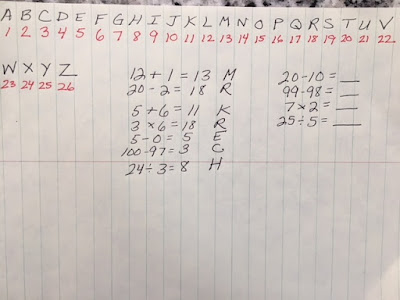Hi All,
We're probably all still learning each others' names at school at this point in the year, so here's one more "mathy" name activity.
Kids love secret codes and patterns. I think we all do actually. This is a simple code, but it lends itself well to differentiating a lot of mathematical operations.
Match every letter with its ordinal position in the alphabet––for example, A = 1, B = 2, C = 3, Z = 26. To get children started have them create a decoder chart where they list all the associated letters and numbers, A to Z, 1 to 26.
Next have students write their names out and pair with the associated number. So, J-A-N-E would be 10-1-14-5. Now, they should get a blank index card (the clue card!) and write out incomplete equations that will yield the numbers they need to "spell" their names.
Jane might use these:
5 + 5 =
100 - 99 =
7 + 7 =
9 - 4 =
This is where you can really differentiate. Students could use multiplication, division, subtraction, addition, even square roots or exponents to express the letters in their names, depending on ability.
Once the clues cards are complete, collect them and pass them out randomly around the room. Each student should use their mathematical knowledge and their decoder chart to figure out whose card they have by solving the secret coded name/message. As students complete the task have them return the card to the person named there.
Simple, but fun. Plus, it's a great beginning of the year assessment to see what kind of numbers and operations your kiddos come in knowing and are comfortable using as they create their clues.
Good luck this year, everybody. May the math be with you,
Bob
We're probably all still learning each others' names at school at this point in the year, so here's one more "mathy" name activity.
Kids love secret codes and patterns. I think we all do actually. This is a simple code, but it lends itself well to differentiating a lot of mathematical operations.
Match every letter with its ordinal position in the alphabet––for example, A = 1, B = 2, C = 3, Z = 26. To get children started have them create a decoder chart where they list all the associated letters and numbers, A to Z, 1 to 26.
Next have students write their names out and pair with the associated number. So, J-A-N-E would be 10-1-14-5. Now, they should get a blank index card (the clue card!) and write out incomplete equations that will yield the numbers they need to "spell" their names.
Jane might use these:
5 + 5 =
100 - 99 =
7 + 7 =
9 - 4 =
This is where you can really differentiate. Students could use multiplication, division, subtraction, addition, even square roots or exponents to express the letters in their names, depending on ability.
Once the clues cards are complete, collect them and pass them out randomly around the room. Each student should use their mathematical knowledge and their decoder chart to figure out whose card they have by solving the secret coded name/message. As students complete the task have them return the card to the person named there.
Simple, but fun. Plus, it's a great beginning of the year assessment to see what kind of numbers and operations your kiddos come in knowing and are comfortable using as they create their clues.
Good luck this year, everybody. May the math be with you,
Bob



Comments
Post a Comment